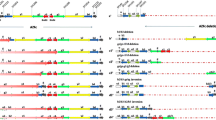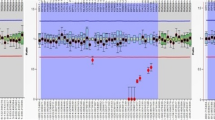Abstract
Purpose
AZFc deletions are associated with variable testicular histology ranging from the Sertoli cell only to spermatogenic arrest and hypospermatogenesis. Such variable phenotypes may be explained by progressive germ cell regression over time. Increased apoptosis is likely responsible for progressive regression of spermatogenic potential. This study evaluated germ cell apoptosis as a cause of the progressive decrease in the number of germ cells in patients with AZFc deletions.
Methods
This study evaluated germ cell apoptosis in patients with AZFc deletions. A total of 151 patients who were diagnosed with either severe oligozoospermia or non-obstructive azoospermia were screened for Y chromosome microdeletions. Germ cell apoptosis was examined using terminal deoxy-nucleotidyl transferase-mediated digoxigenin-dUTP nick-end labeling (TUNEL) on formalin-fixed 5-µm sections of testicular specimens.
Results
Seven out of 117 (6.0%) patients with azoospermia and 4 of 34 (11.8%) patients with severe oligozoospermia had Y chromosome microdeletions. The percentage of apoptotic germ cells in the testes of patients with AZFc deletions were significantly increased compared to those of patients without AZFc deletions.
Conclusions
These results suggest that increased apoptosis of germ cells is responsible for the progressive decline of spermatogenic potential in patients with AZFc deletions.
Similar content being viewed by others
References
Ferlin A, Arredi B, Foresta C. Genetic causes of male infertility. Reprod Toxicol. 2006;22:133–41.
Huang WJ, Lin Y, Hsiao KN, Eilber KS, Salido EC. Restricted expression of the human DAZ protein in premeiotic germ cells. Hum Reprod. 2008;23:1280–9.
Girardi SK, Mielnik A, Schlegel PN. Submicrocsopic deletions in the Y chromosome of infertile men. Hum Reprod. 1997;12:1635–41.
Simoni M, Carani C, Gromoll J, Meschede D, Dworniczak B, et al. Screening for deletions of the Y chromosome involving the DAZ gene in azoospermia and severe oligozoospermia. Fertil Steril. 1997;67:542–7.
Calogero AE, Garofalo MR, Barone N, Palma AD, Vicari E, et al. Spontaneous regression over time of the germinal epithelium in a Y chromosome-microdeleted patient. Hum Reprod. 2001;16:1845–8.
Dada R, Gupa NP, Kucheria K. Molecular screening for Yq microdeletion in men with idiopathic oligozoospermia and azoospermia. J Biosci. 2003;28:163–8.
Dada R, Gupta NP, Kucheria K. Yq microdeletions—Azoospermia factor candidate genes and spermatogenic arrest. J Biomol Tech. 2004;15:176–83.
Ferilin A, Arredi B, Speltra E, Cazzadore C, Selice R, et al. Molecular and clinical characterization of Y chromosome microdeletions in infertile men. A 10-year experience in Italy. J Clin Endocrinol Metab. 2007;92:762–70.
Tesarik J, Greco E, Cohen-Bacrie P, Mendoza C. Germ cell apoptosis in men with complete and incomplete spermiogenesis failure. Mol, Hum Reprod. 1998;4:757–62.
Lin WW, Lipshultz LI, Lamb DJ, Kim ED, Wheeler TM. In situ end-labeling of human testicular tissue demonstrates increased apoptosis in conditions of abnormal spermatogenesis. Fertil Steril. 1997;68:1065–9.
Takagi S, Itoh N, Kimura M, Sasao T, Tsukamoto T. Spermatogonial proliferation and apoptosis in hypospermatogenesis associated with nonobstructive azoospermia. Fertil Steril. 2001;76:901–7.
Kim S, Yoon Y, Park Y, Seo JT, Kim JH. Involvement of the Fas-Fas ligand system and active caspase-3 in abnormal apoptosis in human testis with maturation arrest and Seltoli cell-only syndrome. Fertil Steril. 2007;87:547–53.
McLachlan RI, Meyts ER, Hoei-Hansen CE, Kretser DM, Skakkebaek NS. Histological evaluation of the human testis—approaches to optimizing the clinical value of the assessment. Hum Reprod. 2007;22:2–16.
Sawai H, Komori S, Koyama K. Molecular analysis of the Y chromosome AZFc region in Japanese infertile males with spermatogenic defects. J Reprod Immunol. 2002;53:37–44.
Carvalho CMB, Fujisawa M, Shirakawa T, Gotoh A, Kamidono S, et al. Lack of association between Y chromosome haplogroups and male infertility in Japanese men. Am J Med Genet A. 2003;116:152–8.
Nagata Y, Fujita K, Banzai J, Kojima Y, Kashima K, et al. Seminal plasma inhibin B level is a useful predictor of the success of conventional testicular sperm extraction in patients with non-obstructive azoospermia. J Obstet Gynaecol Res. 2005;31:384–8.
Oates RD, Silber S, Brown LG, Page DC. Clinical characterization of 42 oligospermic or azoospermic men with microdeletion of the AZFc region of the Y chromosome, and of 18 children conceived via ICSI. Hum Reprod. 2002;17:2813–24.
Frydelund-Larsen L, Krausz C, Leffers H, Andersson AM, Carlsen E, et al. Inhibin B: A marker for the functional state of the seminiferous epithelium in patients with asoospermia factor c microdeletions. J Clin Endocrinol Metab. 2002;87:5618–24.
Dunkel L, Hirvonen V, Erkkila K. Clinical aspects of male germ cell apoptosis during testis development and spermatogenesis. Cell Death Differ. 1997;4:171–9.
Rajpurkar A, Jiang Y, Dhabuwala CB, Dunbar JC, Li H. Cigarette smoking induces apoptosis in rat testis. J Environ Pathol Toxicol Oncol. 2002;21:243–8.
Cozzolino DJ, Lipshultz LI. Varicocele as a progressive lesion: positive effect of varicocele repair. Hum Reprod Update. 2001;7:55–8.
Hassan A, EL-Nashar EM, Mostafa T. Programmed cell death in varicocele-bearing testes. Androlagia. 2009;41:39–45.
Skaletsky H, Kuroda-Kawaguchi T, Minx PJ, Cordum HS, Hillier L, et al. The male-specific region of the human Y chromosome is a mosaic of discrete sequence classes. Nature. 2003;423:825–37.
Maines JZ, Wasserman SA. Post-transcriptional regulation of the meiotic Cdc25 protein Twine by the Dazl orthologue Boule. Nat Cell Biol. 1999;1:171–4.
Venables JP, Ruggiu M, Cooke HJ. The RNA-binding specificity of the mouse Dazl protein. Nucleic Acids Res. 2001;29:2479–83.
Morgan DO. Prnciples of CDK regulation. Nature. 1995;374:131–4.
Wickramasinghe D, Becker S, Ernst MK, Resnick JL, Centanni JM, et al. Two CDC25 homologues are differentially expressed during mouse development. Development. 1995;121:2047–56.
Mizoguchi S, Kim KH. Expression of cdc25 phosphatases in germ cells of the rat testis. Biol Reprod. 1997;56:1474–81.
Kar S, Wang M, Carr BI. 2-methoxyestradiol inhibits hepatocellular carcinoma cell growth by inhibiting Cdc25 and inducing cell cycle arrest and apoptosis. Cancer Chemother Pharmacol. 2008;62:831–40.
Acknowledgements
We appreciate the excellent technical assistance of Miss Ai Ikarasi and Mrs. Hiroimi Ihana.
Author information
Authors and Affiliations
Corresponding author
Additional information
Capsule Males carrying AZFc deletions exhibit diminished sperm cell numbers due to an enhanced incidence of apoptosis.
Rights and permissions
About this article
Cite this article
Yamada, K., Fujita, K., Quan, J. et al. Increased apoptosis of germ cells in patients with AZFc deletions. J Assist Reprod Genet 27, 293–297 (2010). https://doi.org/10.1007/s10815-010-9400-0
Received:
Accepted:
Published:
Issue Date:
DOI: https://doi.org/10.1007/s10815-010-9400-0




